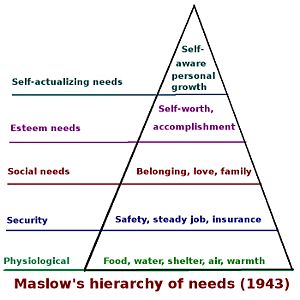Humanistic psychology: Difference between revisions
imported>Howard C. Berkowitz (New page: '''Humanistic psychology''', as a general concept, began with The works of Abraham Maslow and his hierarchy of human needs. As a therapeutic technique, in psychotherapy started in...) |
imported>Howard C. Berkowitz No edit summary |
||
| Line 1: | Line 1: | ||
'''Humanistic psychology''', as a general concept, began with The works of [[Abraham Maslow]] and his [[hierarchy of human needs]]. | '''Humanistic psychology''', as a general concept, began with The works of [[Abraham Maslow]] and his [[hierarchy of human needs]]. | ||
==Human needs== | |||
In 1937, he began to teach at Brooklyn College, [[City University of New York]], and produced some of his best-known work. During this time, he said he was inspired by colleagues including the anthropologist [[Ruth Benedict]] and [[Gestalt psychology|Gestalt]] psychologist [[Max Wertheimer]], whom he was to regard as models of "self-actualizing" people operating at the highest level of human consciousness. Earlier researchers such as Freud had focused on illness, while Pavlov looked for actions dictated by other than conscious choice. Maslow, however, was interested in the optimal, conscious capabilities of people.<ref name=PBS>{{citation | |||
| url = http://www.pbs.org/wgbh/aso/databank/entries/bhmasl.html | |||
| publisher = [[PBS]] | |||
| title = A Science Odyssey — People and Discoveries: Abraham Maslow (1908-1970)}}</ref> | |||
{{Image|Maslow_Hierarchy_of_Needs.jpg|left|300px|Maslow proposed that basic needs must be met first before higher–level needs could be realized.}} | |||
He proposed the hierarchy of needs model in 1943 in a paper entitled ''A Theory of Human Motivation'', which assumed people had a [[hierarchy of needs]], and that it was necessary for the basic needs to be fulfilled first before advancing on to more sophisticated needs. | |||
==Humanistic psychotherapy== | |||
As a therapeutic technique, in psychotherapy started in the [[1950s]] with [[Carl Rogers]]. Rogers, who went to [[Columbia University]], earned a PhD and simultaneously became interested in [[existentialism]]. By the early 1930s he had finished his doctoral work and had brought [[Person centered psychotherapy]] into mainstream focus. Rogers' basic tenets were [[unconditional positive regard]], genuineness, and [[empathy|empathic understanding]], with each demonstrated by the [[wiktionary:Counselor|counselor]]. According to Rogers, these tenets were both necessary and sufficient to create a relationship conducive to enhancing the client's psychological well being, by enabling the client to fully experience themselves. | As a therapeutic technique, in psychotherapy started in the [[1950s]] with [[Carl Rogers]]. Rogers, who went to [[Columbia University]], earned a PhD and simultaneously became interested in [[existentialism]]. By the early 1930s he had finished his doctoral work and had brought [[Person centered psychotherapy]] into mainstream focus. Rogers' basic tenets were [[unconditional positive regard]], genuineness, and [[empathy|empathic understanding]], with each demonstrated by the [[wiktionary:Counselor|counselor]]. According to Rogers, these tenets were both necessary and sufficient to create a relationship conducive to enhancing the client's psychological well being, by enabling the client to fully experience themselves. | ||
Inspired by Rogers, others followed his mode of thinking like [[Fritz Perls|Fritz]] and [[Laura Perls]] in the creation of [[Gestalt therapy]], as well as Marshall Rosenberg, founder of [[Nonviolent Communication]]. Rogers' technique of active listening is considered fundamental to most counseling styles, and is included in virtually every counselor preparation program. | Inspired by Rogers, others followed his mode of thinking like [[Fritz Perls|Fritz]] and [[Laura Perls]] in the creation of [[Gestalt therapy]], as well as Marshall Rosenberg, founder of [[Nonviolent Communication]]. Rogers' technique of active listening is considered fundamental to most counseling styles, and is included in virtually every counselor preparation program. | ||
Revision as of 23:14, 16 August 2010
Humanistic psychology, as a general concept, began with The works of Abraham Maslow and his hierarchy of human needs.
Human needs
In 1937, he began to teach at Brooklyn College, City University of New York, and produced some of his best-known work. During this time, he said he was inspired by colleagues including the anthropologist Ruth Benedict and Gestalt psychologist Max Wertheimer, whom he was to regard as models of "self-actualizing" people operating at the highest level of human consciousness. Earlier researchers such as Freud had focused on illness, while Pavlov looked for actions dictated by other than conscious choice. Maslow, however, was interested in the optimal, conscious capabilities of people.[1]
He proposed the hierarchy of needs model in 1943 in a paper entitled A Theory of Human Motivation, which assumed people had a hierarchy of needs, and that it was necessary for the basic needs to be fulfilled first before advancing on to more sophisticated needs.
Humanistic psychotherapy
As a therapeutic technique, in psychotherapy started in the 1950s with Carl Rogers. Rogers, who went to Columbia University, earned a PhD and simultaneously became interested in existentialism. By the early 1930s he had finished his doctoral work and had brought Person centered psychotherapy into mainstream focus. Rogers' basic tenets were unconditional positive regard, genuineness, and empathic understanding, with each demonstrated by the counselor. According to Rogers, these tenets were both necessary and sufficient to create a relationship conducive to enhancing the client's psychological well being, by enabling the client to fully experience themselves.
Inspired by Rogers, others followed his mode of thinking like Fritz and Laura Perls in the creation of Gestalt therapy, as well as Marshall Rosenberg, founder of Nonviolent Communication. Rogers' technique of active listening is considered fundamental to most counseling styles, and is included in virtually every counselor preparation program.
